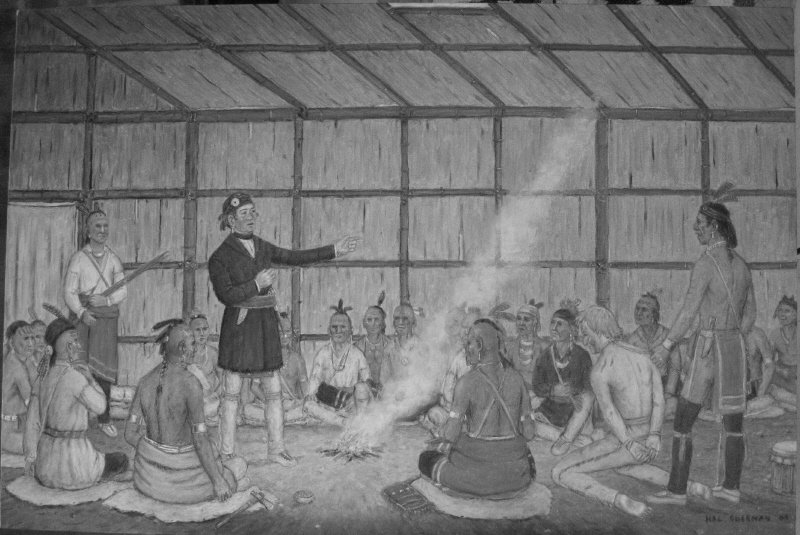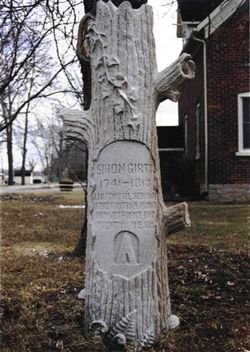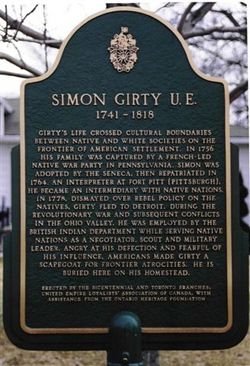SIMON GIRTY
History's realities are seldom dull.
"Simon Girty was a sharp-witted, rascally, many-tongued frontiersman whose epic adventures span the French and Indian War, Dunmore’s War, the American War for Independence, the Indian Wars, and finally, the War of 1812."
Simon Girty, Turncoat Hero
by
Phillip W. Hoffman
The early 1790s were perilous times for Upper Canada. During much of this turbulent period, guerilla warfare between Natives and whites raged across the undefined, wideopen, western lands of the continent. The restlessly roaming residents of the young Republic, probed, then penetrated, the frontiers of the unexplored West in a relentless quest for ever-more new land. In fact, an underlying cause of the American Revolution was the passionate pursuit of Indian land by Americans, including some of so-called founding fathers, one of whom was George Washington. They expressed unrelenting dissatisfaction with the restrictions imposed upon their land speculation ambitions by the King’s Proclamation of 1763.
Known simply as 'Indian territory,' this vast, sweeping country was peopled by roving bands of Aboriginals, some of whom professed allegiance to Great Britain. Funded by the British in their struggle to retain their birthright, they in turn pledged their willingness "to join His Majesty's arms," while focussing their fury on American squatters. Tensions over this frontier fighting threatened to explode and engulf Upper Canada.
The aim of British diplomacy was to maintain the territory north of the Ohio and east of the Mississippi as a Native satellite state which would serve as a buffer separating the Americans from English settlements in Upper Canada. John Graves Simcoe dedicated himself to the task of creating this zone between the United States and Upper Canada and his unlikely allies in this process were agents of the British Indian Department.
Like mist in an autumn morning, the real history of these furtive figures has vanished with wind. Dubbed "provocateurs" by President George Washington, these fearless partisans or reprehensible renegades - depending on whether one supported King or Congress - flitted about the frontier, accused by their rabid critics of instigating a border campaign of pillage, plunder, menace and mayhem.
Simcoe had no control over these stealthy scouts and regularly criticized them as being dangerous and dishonest. Nonetheless, they served his purposes for these Indian agents counselled the Natives and kept them supplied with guns and other goods. These included vast supplies of vermilion, a red colouring used "by the young men to paint themselves and as necessary to them as food."
The agents never advocated all out war between the Aboriginals and the Americans. In fact, they cautioned against it knowing full well that the outcome would be disastrous for the Natives and, perhaps, for the British settlements. War Chiefs and braves needed no prompting from partisans to take up the hatchet and they eagerly used wilderness hit and hide raids to avenge old vendettas against the Long Knives.
American settlers had an insatiable thirst for Western lands and the Aboriginals were just as relentless in their determination to stem the surging tide of trespassers flowing into their quickly vanishing once- limitless lands. Word went out through the Aboriginal villages, "The Whiteman will plant no corn north of the Ohio."
Simon Girty was one of the better known Indian department scouts whose fame or infamy depended on whether one were British or American. Prior to the revolution Girty had been a second-lieutenant in the Pennsylvania militia and a Native interpreter at Fort Pitt. When the revolution began and it was suspected that Girty had Loyalist leanings, he was confined to the American fort. He managed to escape in 1778 and travelled to Detroit were he joined the British Indian Department as a captain and interpreter. His loss was a blow to the Americans because of his knowledge of and influence with the Natives. Thereafter they called him the"Great Renegade."
Born near Harrisburg, Pennsylvania in 1741, Simon was one of four sons raised by an Irish Indian trader settled in eastern Pennsylvania. During the French and Indian War, when he is fifteen, Simon and his family were captured by hostile Shawnee and Delaware warriors led by French officers. Given away to a war party of Senecas, Simon and his two brothers were carried north and adopted.Simon emerged eight years later at age twenty-three, a gifted linguist and a trained interpreter fluent in eleven native languages. Someone later recalled that Girty was a wild-looking individual whose somewhat sinister face was made more so by Joseph Brant who laid his cheek open wih a sabre. Fully six feet tall with impressive build, large head and great,black eyes he was tough and temperamental with rough manners and a grim sense of humour born of the harsh conditions in which he spent his life. He displayed great ability in his work with Natives for he understood their ways and deftly converted Aboriginal resentment of American expansion into support for British military strategy. He became an important source of British intelligence regarding the Indians and the American army's movements. In the summer of 1784, he married Catherine Malott, reputedly the most beautiful woman in Detroit, who had been a captive of the Delaware Indians of Ohio.
Girty was a man of great ability in working with Native leaders and he attended most Aboriginal conferences as official interpreter. He advised Native leaders to refuse American requests for land cessions and urged them to unify their forces. Girty was present at the meeting of a deputation of Indians representing nations assembled at the foot of the Rapids of the Miami River. Prior to their meeting, Girty successfully pressed the tribes to insist on the Ohio river as the boundary. At the conference held on August 1, 1793, attended by the Natives and three American Commissioners, a Wyandot chief, whose name signified Carry-one-about, spoke and Simon served as his interpreter. The Commissioners were informed that the Indians considered the boundary between their land and the American land to be the Ohio River. "Brothers, many years ago we all know that the Ohio was made the boundary: it was settled by Sir William Johnson. This side is ours; we look upon it as our property. The line has been fixed long ago. Brothers, we do not say much. There has been much mischief on both sides. We came here in peace and thought you did the same. We will talk to our head warriors and you may return whence you came and tell Washington." The Americans replied that they would not make the Ohio the boundary. The business, they said, "is now at an end." They blamed "the stubborn Indian intransigence on evil advisers." On the first fair wind, they sailed to Fort Erie from where they returned home to "report our proceedings to the President ofthe United States."
The turmoil of the times provided opportunities to pay off old grudges with lightning fast surprise attacks, during which captives were seized and much-needed munitions taken. The Americans replied with punitive forays of their own, raining down death and destruction on anyone found in the Native villages. It was during one of the Aboriginal raids, that an American named Colonel William Crawford, a good friend of George Washington, was captured and killed. Girty was present as Crawford was tortured to death and widely criticized for not saving him. Some writers even suggested that he taunted Crawford during his agony. Girty maintained he did all he could to save Crawford, indicating that had he persisted beyond what he did, he would have suffered the same fate. His presence at the horrible death of Crawford was seized upon by those who hated him and served to generate extensive propaganda by American writers about this 'white savage'. Not a few of these fanciful fiction writers fed on such incidents and frequently twisted the truth to fit the accusations and their readers who ate it up. Stories of the wild west sold well and kept public opinion aflame.
 |
Simon Girty Saving Simon Kenton
by
Hal Sherman
|
Girty, however is also credited with saving the lives of many American prisoners captured by the natives, often by buying their freedom at his own expense. One of these individuals was his old associate, Simon Kenton, who was captured and about to be tortured. Girty exerted himself to the utmost to successfully save him from a fate worse than death and subsequently succeed in achieving his release.
Information came to the British on the 2nd of June, 1794, from an Irish deserter from the American army. He said that a number of American soldiers ess and paint themselves like Indians to scout about." They were to receive 40 dollars for every Indian scalp they collected and 1000 dollars for the scalp of Simon Girty. The $1000 price tag on Girty's head and the "growth of Girty's 'savage' reputation stem from this period." Stories of Girty's fierce and brutal behaviour abounded, fanned and fed by writers who found it more convenient to blame him for the hostilities occurring between the western tribes and the new republic. This they realized was more acceptable alternative than telling the truth and alienating American readers by blaming pioneer pressures for their acquisition of ever-more Aboriginal land and the failure of the American government to honour its treaties.
Britain was accused of inciting Natives against the settlers and fanning their hostility into a war with the United States. Notwithstanding the agents' agitation, Britain's real policy was to preserve peace for a general conflict would have endangered Upper Canada's very existence. While the Indian agents certainly intensified the Aboriginals' will to resist they cautioned them to concentrate their attacks on vulnerable American supply trains and avoid direct battles. However, Native braves became emboldened by their numerous small victories and "unanimously determined to defend their country," decided on a collective confrontation with their foe.
A few weeks before they clashed with General Anthony Wayne's American forces Native chiefs met with a British officer and requested help.
In Their Own Words
"Here is the hatchet we buried under the leaves and which we now return to you to sharpen for you and us that we may better be able to strike the Big Knives. Hurry and rub off the rust as there is no time to be lost."
The officer responded
In His Own Words
"I cannot march with your warriors to war without the Great Father's orders."Those orders were never given.
Wayne spoke to a number of Native sachems a week before the battle and warned them that they were being misled
In His Own Words
"by bad and designing men and deceived by false promises and language of those who have neither the power nor inclination to protect you."
Led by the Shawnee war chief, Blue Jacket, "a brave, masculine figure of a man and the most noble in appearance of any Indian I ever saw," some thirteen hundred braves called Blue Jacket's war party, met a large American force commanded by Wayne at a place called Fallen Timbers near Waterville, Ohio in August 1794. In forty minutes the Natives were decisively defeated.
The battle took place almost under the walls of the British Fort Miamis to which the routed Indians fled only to find the gates of the fort closed. Governor Simcoe ordered the opening of an extra hospital at Fort Detroit to treat wounded warriors but he could offer little else. The Aboriginals' old ally, Great Britain, had no intentions of joining the fray. The Natives caught up in the contest for a continent by two great powers were now on their own.
Girty was present at the battle but only as an observer. Because he remained "at a respectful distance from the fighting", his influence with the warriors died that day. He remained on the Indian department payroll at 5s 8d per diem, but the atmosphere of crisis in which he had formerly worked was at an end. For a man who had spent his entire life in the midst of the struggle that was Indian-white warfare, the heyday of heroics was over.
The British ceded control of Detroit in 1796. On July 11, 1796, British Colonel Richard England and his troops marched out of Fort Detroit and turned it over to the American Captain Moses Porter. Wayne's army waited discreetly some distance away. Simon Girty was high on the American hit list and barely managed to escape their clutches. Seeing the approaching American troops, he held onto his horse's tail and swam with it across the Detroit River to Canada, hurling invectives all the way. Simon settled near Amherstburg, Ontario, on land given him by the British government for his loyalty. He resided there until his death. His memorial stone and plaque are at 1173 Front Road South, Highway 18 on the Detroit Riverfront, Malden Township, Essex County, Ontario, Canada.
 |
Simon Girty Memorial Stone
|
 |
Simon Girty Provincial Plaque
|
Feared and hated on the American frontier, Simon Girty eventually retired to a farm in Amherstberg, Upper Canada where he raised corn for the government. Blind, crippled and a shadow of his former self, he spent his happiest hours at his favourite public house recounting tales of his spine-tingling career. Even then a $1,000 American bounty remained on his head. He died on the 18th of February, 1818. Warriors on both sides of the Canadian border respected and remembered him fondly. To the Mohawks, Simon Girty was to become an "Indian Patriot." American frontiersmen called him a white savage and years later, Kentuckians crossed the Detroit River into Canada "just for the satisfaction of spitting on his grave."
By the Treaty of Greenville signed in February 1795, "permanent peace was declared with all the Indian Nations North West at the Ohio." By this treaty the Aboriginal tribes yielded the southeast corner of the Northwestern Territory to the Americans for annuities valued at $10,000. The sachems believed they had bought peace and preserved what was left of their lands. They thought they had seen the last of the whiteman's wagons.
Within a decade the settlers' ravenous appetite for ever more acres served notice to the Natives that once again their lands were in jeopardy from the swelling masses of white settlers whose numbers never seemed to end. Further and further back the Natives fell, fighting all the way as they packed the pages of history with battles that had begun when the first arrow was fired at the first firearm.
Copyright © 2013 Website Administrator |







